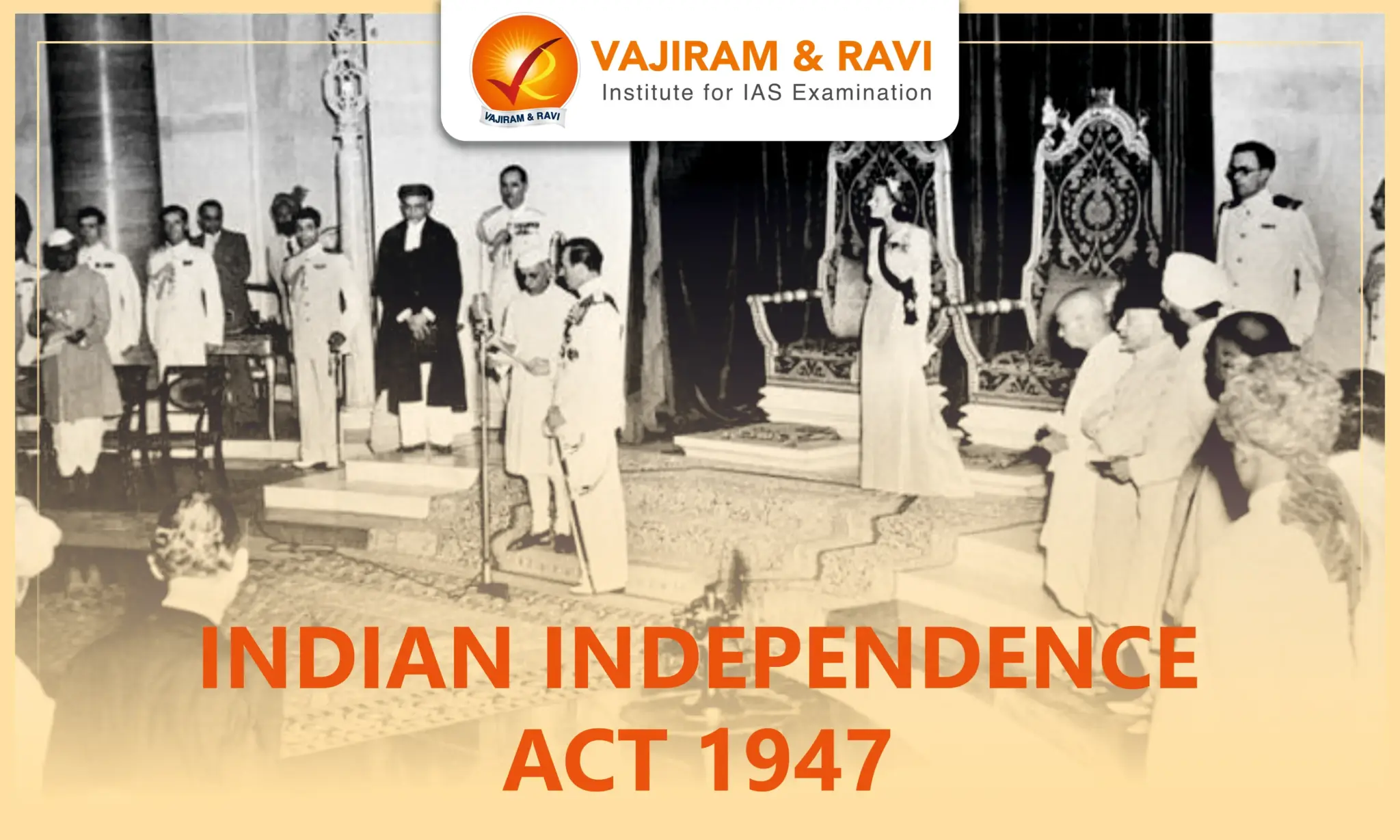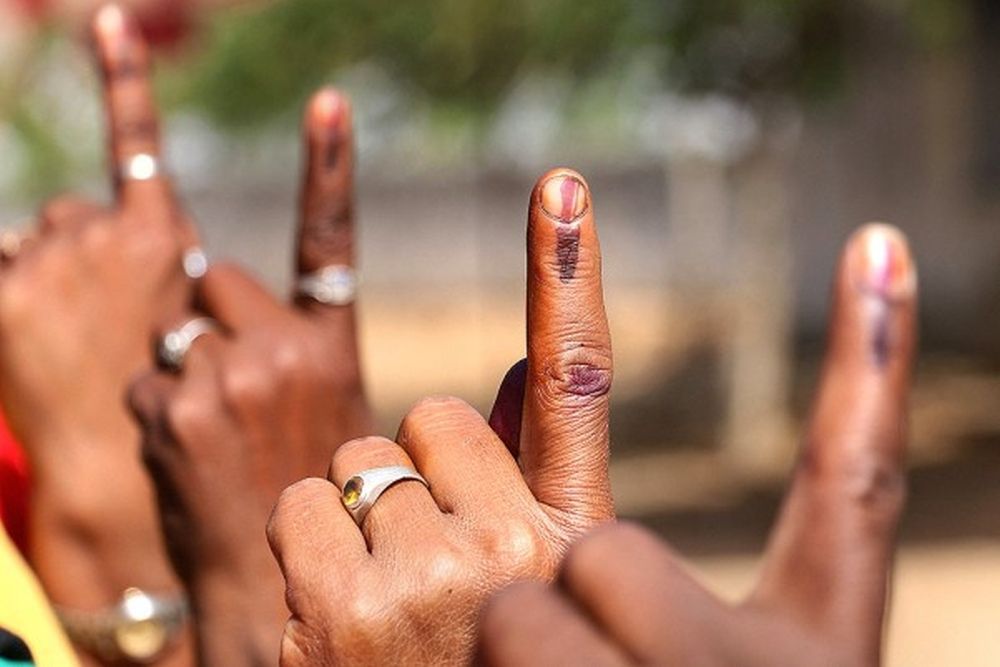The Indian Independence Act 1947 was a landmark piece of legislation passed by the British Parliament that paved the way for the partition of British India and the establishment of two independent dominions: India and Pakistan.
On August 15, 1947, the act effectively ended British colonial rule in the Indian subcontinent by establishing sovereignty for the newly formed nations. This legislation marked the end of decades of struggle for independence and paved the way for the birth of modern India and Pakistan.
What is the Indian Independence Act 1947?
The Indian Independence Act 1947 was an act of the United Kingdom Parliament that divided British India into two new independent dominions, India and Pakistan. The Act was passed in the British Parliament on July 5, 1947, and received Royal Assent on July 18, 1947. Modern-day India and Pakistan, including the West (modern-day Pakistan) and East (modern-day Bangladesh) regions, were established on August 15, 1947.
- The Mountbatten Plan, developed by Louis Mountbatten, India’s last Governor-General, served as the foundation for the Indian Independence Act 1947.
- He had devised a plan to hand over power to the natives from the British Crown. The Act resulted from the Indians’ years of struggle and resistance to the British occupation.
Indian Independence Act 1947 Background
The background to the Indian Independence Act of 1947 is deeply rooted in the long and arduous struggle for Indian independence. After the Revolt of 1857, the early 20th century saw the rise of the Indian National Congress (INC), which played a crucial role in advocating for self-rule.
- Continued Struggle for Independence: The struggle for independence gained traction over time, culminating in events such as the Non-Cooperation Movement and the Civil Disobedience Movement. The demand for independence was further intensified during and after World War II, as the British Empire weakened and the Indian independence movement intensified.
- Role of Quit India Movement: The Quit India Movement of 1942, led by Mahatma Gandhi, was a significant effort to end British rule. However, communal tensions between Hindus and Muslims, exacerbated by British political strategies, prompted calls for a separate Muslim state. The Muslim League’s Lahore Resolution of 1940, which called for the creation of Pakistan, laid the groundwork for partition.
- Failure of Cabinet Mission Plan: The Cabinet Mission Plan of 1946, which sought to keep India united while granting autonomy to provinces, failed to achieve consensus, resulting in widespread communal violence.
- Attlee’s Announcement: On 20 February 1947, British Prime Minister Clement Attlee announced plans to transfer power. The announcement stated that the British Government would grant full self-government to British India by June 3, 1948, at the latest, and that the fate of the Princely States would be decided after the date of the final transfer was determined.
- Mountbatten Plan (3rd June Plan): As the situation deteriorated due to communal violence, Lord Mountbatten, the last Viceroy of India, proposed the partition plan, known as the Mountbatten Plan. The Congress and the Muslim League agreed to the plan. The plan took immediate effect when the Indian Independence Act of 1947 was enacted.
Indian Independence Act 1947 Features
The Indian Independence Act of 1947 transformed British India’s political landscape. It not only divided the subcontinent into India and Pakistan but also ended British sovereignty and redefined governance structures, affecting everything from boundary demarcation to civil service appointments.
- Partition of British India: The Indian Independence Act 1947 divided British India into two separate dominions—India and Pakistan—each with the right to secede from the British Commonwealth if they choose.
- End of British sovereignty: The Indian Independence Act 1947 ended British legal sovereignty over India, transferring all powers previously held by the British government to the new dominions. It also removed the Emperor of India title from the King of England’s royal titles.
- Abolishment of Office of Viceroy: The Indian Independence Act 1947 abolished the office of Viceroy and established a governor-general for each dominion, which the British King would appoint based on the advice of the dominion cabinet. His Majesty’s Government in Britain was to have no responsibility for the governments of India and Pakistan.
- Empowerment of Constituent Assemblies: The Indian Independence Act of 1947 allowed the Constituent Assemblies of India and Pakistan to draft their constitutions and repeal British laws, with no new British laws applying unless adopted by the dominion legislatures.
- Boundary Demarcation: The Act established the borders of India and Pakistan, with a boundary commission led by Sir Cyril Radcliffe determining the division, which led to significant migrations and communal violence.
- Abolishment of Secretary of State for India: The Indian Independence Act 1947 abolished the office of Secretary of State for India and delegated its responsibilities to the Secretary of State for Commonwealth Affairs.
- Fate of Princely States: The Indian Independence Act 1947 proclaimed the end of British supremacy over Indian princely states and treaty relations with tribal areas on August 15, 1947. It granted Indian princely states the freedom to join the Dominion of India or the Dominion of Pakistan or to remain independent.
- Governance Structure: The Indian Independence Act 1947 established a framework for each dominion’s government. The two dominions were allowed to adopt the Government of India Act of 1935 as their interim constitution, with the flexibility to make changes as needed.
- It took away the British Monarch’s right to veto or request that specific bills be reserved for his approval.
- However, this authority was reserved for the Governor General. The Governor-General would have full authority to sign any bill in His Majesty’s name.
- Governor-General Appointment: The Indian Independence Act 1947 appointed the Governor-General of India and the provincial governors as the constitutional (nominal) heads of the states. They were required to follow the advice of the respective council of ministers in all matters.
- Discontinuation of Civil Service Appointment: The Indian Independence Act 1947 abolished civil service appointments and post-reservation by the Secretary of State for India. Members of the civil service appointed before August 15, 1947, would continue to receive all benefits to which they were entitled until that date.
Indian Independence Act 1947 Significance
The Indian Independence Act of 1947 ended nearly 200 years of British rule and established India and Pakistan as sovereign nations. It set the stage for decolonization, constitutional development, and global power shifts.
- End of Colonial Rule: The Indian Independence Act of 1947 ended nearly 200 years of British rule, leading to the creation of the sovereign states of India and Pakistan.
- Resolution of the Communal Issue: Partition fulfilled the Muslim League’s demand for Pakistan but caused massive migrations and communal violence.
- Influence on Decolonisation: India’s independence inspired other colonies to seek freedom, driving the broader decolonization movement in Asia and Africa.
- Foundation for Constitutional Development: The Act enabled India and Pakistan to draft their constitutions, with India’s 1950 Constitution establishing it as the world’s largest democracy.
- Changes in Global Power Dynamics: Britain’s withdrawal marked the end of its empire, with India and Pakistan emerging as significant global players, reshaping post-World War II geopolitics.
Indian Independence Act 1947 Impacts
The Indian Independence Act 1947 had profound and lasting impacts, including the partition of British India, leading to mass migration and communal violence. It also marked the creation of India and Pakistan as sovereign nations.
- Partition and Violence: The Indian Independence Act of 1947 led to the partition of India and widespread communal violence, displacing millions and causing significant loss of life.
- Mass Migration: The partition triggered one of history’s largest migrations, with Hindus and Sikhs moving to India and Muslims to Pakistan, creating a major humanitarian crisis with lasting effects.
- Integration of Princely States: The integration of princely states into India or Pakistan was complex, with the Kashmir issue remaining unresolved and fueling ongoing conflict.
- Constitutional Development: Both nations began drafting constitutions, with India’s, ratified in 1950, becoming one of the most comprehensive globally.
- Unresolved Issues: The Act left unresolved issues, such as the Kashmir conflict and boundary disputes with China, Bangladesh, and Nepal, continuing to affect India-Pakistan relations.
Indian Independence Act 1947 UPSC PYQs
Question 1: The Radcliffe Committee was appointed to (UPSC Prelims 2014)
(a) solve the problem of minorities in India
(b) give effect to the Independence Bill
(c) delimit the boundaries between India and Pakistan
(d) enquire into the riots in East Bengal
Ans: (d)
Last updated on April, 2025
→ UPSC Notification 2025 was released on 22nd January 2025.
→ The UPSC Vacancy 2025 were released 1129, out of which 979 were for UPSC CSE and remaining 150 are for UPSC IFoS.
→ UPSC Admit Card 2025 is expected to release in first week of May for CSE Prelims Exam 2025.
→ The UPSC Prelims 2025 is scheduled to be conducted on 25th May 2025 and UPSC Mains 2025 will be conducted on 22nd August 2025.
→ Apply once through it and aspirants can apply for various government exams conducted by UPSC.
→ The UPSC Selection Process is of 3 stages-Prelims, Mains and Interview.
→ UPSC Result 2024 is released with latest UPSC Marksheet 2024. Check Now!
→ UPSC Toppers List 2024 is released now. Shakti Dubey is UPSC AIR 1 2024 Topper.
→ Also check Best IAS Coaching in Delhi
Indian Independence Act 1947 FAQs
Q1. What were the three main features of the Indian Independence Act 1947?+
Q2. What was the main clause of the Indian Independence Act of 1947?+
Q3. Which plan was ratified as Indian Independence Act 1947?+
Q4. What is stated in the Indian Independence Act of 1947 about the Indian princely states?+
Q5. Who declared Indian Independence Act 1947?+
















